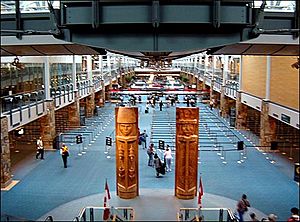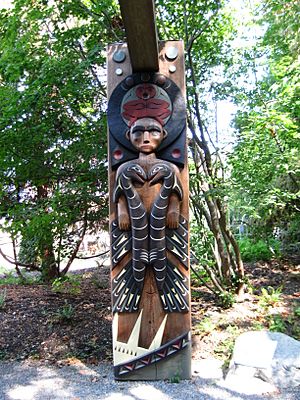Susan Point facts for kids
Quick facts for kids
Susan Point
|
|
|---|---|
| Born | April 5, 1952 |
| Nationality | Musqueam |
| Education | Self-taught |
| Known for | Sculptor |
| Movement | Coast Salish |
| Awards | YWCA Woman of Distinction |
| Elected | Royal Canadian Academy of Arts |
Susan Point (born April 5, 1952) is a famous Canadian artist. She is a member of the Musqueam people, who are part of the Coast Salish First Nations. Her art is inspired by the traditional art of her culture.
Point creates amazing sculptures, prints, and large artworks for public spaces. You can see her work in famous places like the Vancouver International Airport and Stanley Park in Vancouver. Her art is also in museums in Washington, D.C. and Philadelphia.
Contents
Early Life and Career
Susan Point was born in Alert Bay, British Columbia. Her parents were out salmon fishing at the time. At home, her family spoke Halkomelem, a traditional Salish language.
In the 1980s, Point became interested in bringing back traditional Coast Salish art. At the time, not many people were making this type of art. She taught herself by studying old Coast Salish art pieces. She visited museums at the University of British Columbia and the Royal British Columbia Museum to learn.
Point's work became very important for the revival of Coast Salish art. She helped people see the beauty of Salish art, which was different from other art styles of the Northwest Coast. She studied old designs, like those on spindle whorls (tools used for spinning wool), and used them to create new art. She worked with many materials, including glass, concrete, and bronze.
Art and Style
A lot of Point's art is based on the designs of the spindle whorl. She turned these round, carved designs into colorful screen prints. Her work helped people learn more about her culture. By 2016, she had created over 360 different prints.
For many years, Point was very busy. Each year, she would create a large piece of public art in British Columbia or near Seattle. She would also make a series of prints and glass artworks.
In 2017, the Vancouver Art Gallery held a major show of her work. It was called Susan Point: Spindle Whorl.
Famous Artworks
Susan Point has created many well-known artworks. These include carvings, sculptures, and even stained-glass windows.
Flight (Spindle Whorl)
In 1995, Point's huge sculpture "Flight (Spindle Whorl)" was placed in the Vancouver International Airport. It is the largest spindle whorl in the world, measuring 16 feet (4.8 meters) across. The sculpture is set in front of a waterfall made of stone. This shows the connection between the land and the sky.
Buttress Runnels
For the 2010 Winter Olympics, Point created "Buttress Runnels" for the Richmond Olympic Oval. These are special channels that guide rainwater from the building's roof. The channels have designs showing life in the Fraser River, like fish and herons. The heron is an important symbol for both the City of Richmond and the Musqueam people.
Tree of Life Window
In 2009, a beautiful stained-glass window designed by Point was installed in Christ Church Cathedral in Vancouver. It is called “Tree of Life.” The design shows the Salish belief that all living things are connected. It brings together Christian ideas and First Nations culture.
Awards and Honours
Susan Point has received many awards for her art and her contributions to culture.
- She has received honorary doctorate degrees from four universities.
- In 2004, she was appointed to the Royal Canadian Academy of Arts.
- In 2004, she won a National Aboriginal Achievement Award.
- In 2006, she was made an Officer of the Order of Canada, a very high honour in Canada.
- In 2012, she received the Queen Elizabeth II Diamond Jubilee Medal.
- In 2018, she won the Audain Prize for Lifetime Achievement in the Visual Arts.
See also




